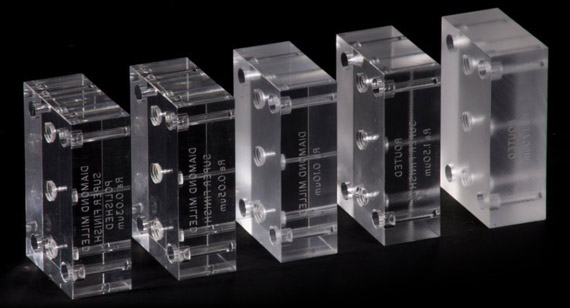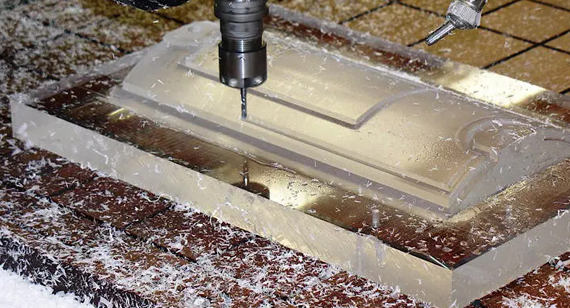15 years one-stop China custom CNC machining parts factory
 151 |
Published by VMT at Oct 17 2024
151 |
Published by VMT at Oct 17 2024
In CNC machining services, the choice of material plays a critical role in the functionality and aesthetics of finished products. Translucent and transparent parts are frequently used in various industries, from consumer electronics and medical devices to automotive and industrial applications. Understanding the differences between translucent and transparent materials, their available types, and the machining processes suited to them is essential for ensuring optimal results.
This guide provides a comprehensive overview of translucent and transparent parts, focusing on the materials and methods available for custom CNC machining, CNC prototype machining, and other manufacturing techniques. Whether you're aiming for clarity, light transmission, or unique aesthetics, this article will help you select the right solution.
Transparent materials are those that allow light to pass through them without significant scattering, allowing objects to be seen clearly through them. These materials are essential in applications where visibility and light transmission are critical, such as lenses, windows, and screens.
Examples of Transparent Materials:
Flat Glass: Widely used in windows, doors, and display cases for its clarity and strength.
Water: A natural transparent substance commonly used in optics and fluid containers.
Spectacles: Glass or plastic lenses designed for corrective or protective eyewear.
Glass: A versatile, transparent material used in construction, automotive, and packaging industries.
Hourglass: Transparent glass allows visibility of the sand inside.
Window: Windows made of glass or acrylic offer unobstructed views and light transmission.
Computer Screen: Transparent materials like glass and plastic are used in electronic displays.
Prism: Made from transparent materials, prisms are used to refract light for scientific and optical purposes.
Fish Tank: Transparent walls allow visibility of the aquatic life inside.
Lens: Lenses made from transparent materials are crucial for cameras, microscopes, and other optical devices.
Translucent materials allow light to pass through but scatter it in a way that objects behind them are not clearly visible. These materials are useful when you want to diffuse light, create privacy, or achieve specific aesthetic effects.
Examples of Translucent Materials:
Frosted Glass: Commonly used in bathrooms and offices, offering privacy while allowing light to pass through.
Colored Glass: Provides aesthetic appeal and light diffusion while still transmitting light.
Wax Paper: Used in food packaging and cooking, allowing partial light transmission.
Ice: Natural ice, while translucent, scatters light as it passes through.
Colored Plastic Bottles: These bottles allow some light to pass through but obscure the objects inside.
Tracing Paper: Used for drawing and drafting, this paper diffuses light and images behind it.
Jelly: Its translucent nature makes it a common material for certain artistic and culinary applications.
Paper Cups: Some paper cups are translucent, allowing light to shine through slightly.
Clouds: Natural examples of translucency, clouds scatter sunlight while still illuminating the sky.
Colored Balloons: Translucent balloons allow light through but make it difficult to see clearly inside.
Transparent and translucent materials differ in how they handle light transmission. Transparent materials allow light to pass through with minimal scattering, providing clear visibility through them. In contrast, translucent materials scatter light as it passes through, making objects behind them difficult to distinguish but still allowing light to permeate. The key difference lies in the clarity and level of visibility provided by each material.

The choice of transparent or translucent parts depends on the intended application and the visual or functional needs of the design. Here are some reasons to use these materials in CNC machined parts:
Visibility
Transparent parts offer complete visibility, making them ideal for applications where monitoring, display, or interaction is necessary. For example, transparent windows in consumer electronics allow users to see internal components or displays.
Light
Both translucent and transparent materials play an essential role in controlling how light is transmitted. Translucent parts are often used to diffuse light, such as in light fixtures, creating a soft and even illumination. Transparent parts, on the other hand, are used in applications where clear light transmission is required, such as lenses or windows.
Aesthetics
Both translucent and transparent materials are valued for their aesthetic properties. They offer a sleek and modern appearance that is often desirable in consumer products, medical devices, and automotive applications. Translucent materials add a frosted or diffused look, while transparent materials provide a clean, high-tech visual.
There are several materials available for CNC machining of translucent and transparent parts, each with its unique characteristics. These materials range from resins used in 3D printing to engineering plastics suitable for CNC machining and injection molding.
Available Materials:
Clear Resin: Used primarily in Stereolithography (SLA), clear resin offers high resolution and transparency for prototyping.
PMMA (Acrylic): Known for its excellent transparency and resistance to scratching, PMMA is widely used in applications such as optical lenses, windows, and display screens.
PC (Polycarbonate): Polycarbonate is another popular transparent material, offering greater impact resistance and heat resistance compared to PMMA.
ABS: While not naturally transparent, ABS can be formulated to be translucent. It is often used in applications requiring durability and some light transmission.
PX520 (PC-Like): PX520 is a material used in vacuum casting that mimics the properties of Polycarbonate, providing transparency with impact resistance.
PX521 (PMMA-Like): PX521 is another casting material that offers clarity similar to PMMA, making it ideal for low-volume transparent parts.
Several manufacturing processes are available for producing translucent and transparent parts. Each process has its advantages and disadvantages depending on the material, quantity, and design complexity.
Stereolithography (SLA)
SLA is a type of 3D printing technology that uses a laser to cure liquid resin into a solid form. It is an ideal process for creating highly detailed transparent or translucent parts quickly and affordably.
Materials: Clear Resin
Advantages:
Very Fast: SLA is ideal for rapid prototyping of transparent parts.
Cost-Effective: For small quantities, SLA is a more affordable option compared to CNC machining or injection molding.
Supports Complex Geometries: SLA can produce intricate and complex parts with ease.
High Resolution: SLA parts have smooth surfaces and high levels of detail.
Disadvantages:
Fragile and Brittle Parts: SLA parts tend to be more brittle than parts produced by CNC machining or injection molding.
Support Structures: Support structures must be removed after printing, which can affect the final surface finish.
Limited Materials: SLA materials are generally limited to specific formulations of resin, which may not meet the needs of every application.
Not Practical for Large Quantities: For larger production runs, SLA becomes impractical or expensive compared to other methods.
CNC Machining of Transparent Parts
CNC machining is a popular choice for producing high-quality transparent parts with tight tolerances. Materials like PMMA (acrylic) and Polycarbonate are often used in CNC machining services to create durable and optically clear parts.

Transparent CNC Materials: PMMA、Polycarbonate.
Advantages:
High Quality: CNC machining produces parts with excellent optical clarity and surface finish.
High Clarity: With proper tooling and finishing techniques, CNC-machined parts can achieve glass-like clarity.
Various Material Options: A wide range of transparent plastics can be machined to meet specific project requirements.
Disadvantages:
Expensive for Large Quantities: While cost-effective for prototypes and small batches, CNC machining becomes expensive for large production runs.
Lower Geometric Freedom: CNC machining may have limitations in producing very complex geometries, especially when compared to 3D printing.
Injection Molded Transparent Parts
Injection molding is a high-volume manufacturing process used to produce transparent parts in large quantities. It is particularly cost-effective for long production runs where consistent quality is required.
Materials: PMMA、Polycarbonate、ABS (Translucent).
Advantages:
High Quality: Injection molding produces parts with high optical clarity and excellent surface finishes.
Cost-Effective for Large Quantities: Injection molding becomes more cost-efficient as production volumes increase.
Wide Range of Materials: Injection molding supports a wide range of transparent and translucent materials.
Disadvantages:
Not Suitable for Small Batches: The cost of molds makes injection molding impractical for small quantities (e.g., 1-100 units).
Geometric Limitations: While injection molding supports complex shapes, there are limitations compared to 3D printing in terms of undercuts and thin features.
Vacuum Casting of Transparent Parts
Vacuum casting is a process that uses silicone molds to produce low-volume parts. It is ideal for creating translucent and transparent parts in small quantities.
Materials: PX520 (PC-like)、PX521 (PMMA-like).
Advantages:
Cost-Effective: Vacuum casting is an affordable alternative to injection molding for low-volume production.
Easy to Dye: Parts made via vacuum casting can easily be dyed to create translucent or colored parts.
Good Appearance: Vacuum casting produces parts with good optical clarity and smooth surface finishes.
Disadvantages:
Not Fully Transparent: Vacuum cast parts may not achieve 100% transparency like CNC-machined or injection-molded parts.
Fragile: Vacuum-cast parts tend to be more fragile and brittle compared to injection-molded or CNC-machined components.
Limited Mold Life: Silicone molds can typically only be used about 20 times before they need to be replaced.
Additional methods for producing transparent and translucent parts include thermal forming, compression molding, and resin casting. These processes are generally used for specialized applications or when specific material properties are required.
After machining or molding, post-processing techniques can further enhance the clarity, surface finish, and appearance of transparent and translucent parts.
Post-Processing Techniques:
Grinding: Used to smooth out rough surfaces and edges.
Polishing and Fumigation: Polishing can improve the optical clarity of transparent materials, while fumigation may be used to remove fine surface imperfections.
Painting or Spraying: Transparent and translucent parts can be coated for aesthetic purposes or to add functional layers like UV protection.
Resin Coating: A clear resin coat can enhance the surface finish and improve optical clarity.
Dyeing: Translucent parts can be dyed to achieve specific color shades while maintaining their light-diffusing properties.
When selecting translucent or transparent parts, it’s essential to consider the material, manufacturing process, and application requirements. Whether you're creating high-precision prototypes through CNC machining or producing large volumes of transparent parts via injection molding, understanding the benefits and limitations of each process will help you make the best choice.
At VMT, we specialize in producing high-quality translucent and transparent parts using advanced CNC machining, 3D printing, and injection molding techniques. Our experienced team can guide you through material selection, design, and post-processing to ensure your parts meet all technical and aesthetic requirements.
What are the 5 types of translucent materials?
Examples of translucent materials include frosted glass, colored plastic bottles, tracing paper, wax paper, and ice.
Is glass sheet transparent or translucent?
A typical glass sheet is transparent, allowing clear visibility through it, although certain types, like frosted glass, are translucent.
Can you polish polycarbonate?
Yes, polycarbonate can be polished to improve clarity and surface finish. Mechanical polishing or flame polishing are common techniques used.
What materials can be polished into transparent parts?
Materials such as PMMA (Acrylic), Polycarbonate (PC), and some clear resins can be polished to achieve transparency.
